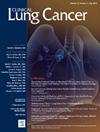Association of Sarcopenia With Toxicity and Survival in Patients With Lung Cancer, a Multi-Institutional Study With External Dataset Validation
IF 3.3
3区 医学
Q2 ONCOLOGY
引用次数: 0
Abstract
Introduction
Sarcopenia is associated with worse survival in non–small cell lung cancer (NSCLC), but less studied in association with toxicity. Here, we investigated the association between imaging-assessed sarcopenia with toxicity in patients with NSCLC.
Methods
We analyzed a “chemoradiation” cohort (n = 318) of patients with NSCLC treated with chemoradiation, and an external validation “chemo-surgery” cohort (n = 108) who were treated with chemotherapy and surgery from 2002 to 2013 at a different institution. A deep-learning pipeline utilized pretreatment computed tomography scans to estimate SM area at the third lumbar vertebral level. Sarcopenia was defined by dichotomizing SM index, (SM adjusted for height and sex). Primary endpoint was NCI CTCAE v5.0 grade 3 to 5 (G3-5) toxicity within 21-days of first chemotherapy cycle. Multivariable analyses (MVA) of toxicity endpoints with sarcopenia and baseline characteristics were performed by logistic regression, and overall survival (OS) was analyzed using Cox regression.
Results
Sarcopenia was identified in 36% and 36% of patients in the chemoradiation and chemo-surgery cohorts, respectively. On MVA, sarcopenia was associated with worse G3-5 toxicity in chemoradiation (HR 2.00, P < .01) and chemo-surgery cohorts (HR 2.95, P = .02). In the chemoradiation cohort, worse OS was associated with G3-5 toxicity (HR 1.42, P = .02) but not sarcopenia on MVA. In chemo-surgery cohort, worse OS was associated with sarcopenia (HR 2.03, P = .02) but not G3-5 toxicity on MVA.
Conclusion
Sarcopenia, assessed by an automated deep-learning system, was associated with worse toxicity and survival outcomes in patients with NSCLC. Sarcopenia can be utilized to tailor treatment decisions to optimize adverse events and survival.
肌减少症与肺癌患者的毒性和生存率的关联,一项具有外部数据验证的多机构研究。
在非小细胞肺癌(NSCLC)中,肌肉减少症与较差的生存率相关,但与毒性相关的研究较少。在这里,我们研究了成像评估的非小细胞肺癌患者肌肉减少症与毒性之间的关系。方法:我们分析了2002年至2013年在不同机构接受化疗和手术治疗的非小细胞肺癌患者的“放化疗”队列(n = 318)和外部验证的“化疗-手术”队列(n = 108)。深度学习管道利用预处理计算机断层扫描来估计第三腰椎水平的SM面积。骨骼肌减少症的定义是二分类SM指数(SM根据身高和性别调整)。主要终点为第一个化疗周期21天内NCI CTCAE v5.0 3 ~ 5级(G3-5)毒性。采用logistic回归对肌肉减少症的毒性终点和基线特征进行多变量分析(MVA),并采用Cox回归分析总生存期(OS)。结果:在放化疗组和化疗组中,分别有36%和36%的患者出现了肌肉减少症。在MVA组,放化疗组(HR 2.00, P < 0.01)和化疗组(HR 2.95, P = 0.02)肌肉减少与更差的G3-5毒性相关。在放化疗组中,更差的OS与G3-5毒性相关(HR 1.42, P = 0.02),但与MVA的肌肉减少无关。在化疗队列中,较差的OS与肌肉减少症相关(HR 2.03, P = 0.02),但与MVA的G3-5毒性无关。结论:通过自动深度学习系统评估的肌少症与NSCLC患者更差的毒性和生存结果相关。肌少症可用于定制治疗决策,以优化不良事件和生存。
本文章由计算机程序翻译,如有差异,请以英文原文为准。
求助全文
约1分钟内获得全文
求助全文
来源期刊

Clinical lung cancer
医学-肿瘤学
CiteScore
7.00
自引率
2.80%
发文量
159
审稿时长
24 days
期刊介绍:
Clinical Lung Cancer is a peer-reviewed bimonthly journal that publishes original articles describing various aspects of clinical and translational research of lung cancer. Clinical Lung Cancer is devoted to articles on detection, diagnosis, prevention, and treatment of lung cancer. The main emphasis is on recent scientific developments in all areas related to lung cancer. Specific areas of interest include clinical research and mechanistic approaches; drug sensitivity and resistance; gene and antisense therapy; pathology, markers, and prognostic indicators; chemoprevention strategies; multimodality therapy; and integration of various approaches.
 求助内容:
求助内容: 应助结果提醒方式:
应助结果提醒方式:


